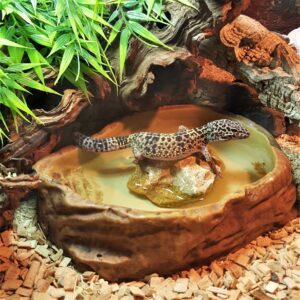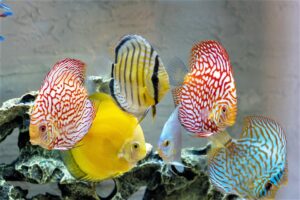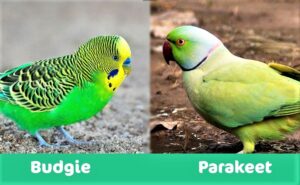
Consider adopting or fostering a small mammal from Minnesota Pocket Pet Rescue.
BY DEBRA KEEFER RAMAGE
Why keep small and unusual pets?
Not everyone can keep a dog or a cat in their living space. For reasons ranging from disabilities to allergies to rules for renters, sometimes if one wants an animal companion, they have to look for other alternatives. I have known people who kept snakes, rabbits, ferrets, spiders and guinea pigs, among other unusual pets, but since we don’t have the space in this article to cover all the options, we will just focus on a few relatively easy to care for options: small reptiles, small mammals, small birds and freshwater fish.
What kind of small reptiles are available to buy or adopt?
Smaller reptiles that are often kept as pets include the leopard gecko, the corn snake, the bearded dragon, the ball python, the red-eared slider, the blue-tongued skink and the chameleon.

A leopard gecko in its tank, complete with pool
Although you can sometimes find reptiles at big box pet stores, or buy or adopt them from friends and other individuals, the Twin Cities has a great resource on reptiles in a place called Snake Discovery. Located in Maplewood, it’s a combination of a reptile zoo, an educational and entertainment resource for kids, a pet supply store, and a reptile rescue and adoption service. Also, Snake Discovery has a YouTube channel with over 2 million subscribers before it was a physical space, which you can explore here: www.youtube.com/watch?v=arRJ_n48F2g.
Before deciding if you want to keep a reptile, you can visit them at Snake Discovery and maybe take part in one of their programs (Totally Turtles, Reptiles Around the World, etc.) or even hold a child’s birthday party in their facility to get up close with some reptiles. If you decide to go for it, check out their adoption policies and procedures at www.snakediscovery.com/adoption-program.
Why small mammals and what kind should you get?
There are lots of species of small mammals available to buy or adopt, some that have been successfully domesticated for many years. Among those recommended online are Syrian hamsters, dwarf hamsters or Chinese hamsters, as well as gerbils, fancy mice, guinea pigs, and chinchillas. Most of these can also be bought at a reputable pet store if you have a way to check for reviews and the legal status of the breeder.
If you want to go the “adopt, don’t shop” route, check out Minnesota Pocket Pet Rescue at www.mnpocketpetrescue.org. They’re a nonprofit dedicated to rescuing rabbits, mice, hamsters and other small pets in danger of premature euthanasia other than for disease, or in danger of abandonment or abuse. If you’re not ready to permanently adopt a tiny mammal, you may want to volunteer with them, temporarily foster a rescued pet, or buy merch from their website store to help support their mission.
Why tropical freshwater fish?
Aquariums full of fish and other life forms are popular with geeky types of people (in which I include myself). While caring for land-based fauna like birds and mammals involves actual caring skills, taking proper care of your fish tank is more like science and less like raising children. If you’re more cerebral and less cuddly, this might be the pet for you. Also, problems caused by other types of pets, such as allergies or noise, are almost unknown amongst aquarium keepers.
What to know before you get that aquarium

Colorful discus fish in a freshwater aquarium
Don’t take this to mean that keeping fish in an aquarium is easy or without possible complications. So as not to inherit someone’s hidden problems, I recommend that the beginner start from scratch. Proper steps are required to do it right, and patience is important. First decide between three types of aquarium environments to go for – freshwater, brackish water or salt water. All other choices for your aquarium start from there.
Salt water is pretty complicated, and is not recommended for the novice, and so we will not cover that option here. Consult a trusted expert. Some experts recommend brackish water over freshwater, and although it does have some advantages, I recommend going with freshwater only for two reasons. First is that brackish water doesn’t support live aquatic plants, at least not the ones commonly available in aquarium stores. (I am making a blanket recommendation against all forms of plastic for your aquarium accessories.) The second reason is just that there is more historical knowledge and more readily available advice and actual “stuff” for freshwater aquariums.
Here’s a good online article about setting up a new freshwater aquarium: www.thatpetplace.com/articles/freshwater-aquarium-basics-article. There is also a terrific book available, possibly at the library or secondhand, titled “Freshwater Aquariums for Dummies.” The short version is that choosing and buying your fish is almost the last step. Before buying fish, to have a safe and healthy environment you must do research, get the right size tank, condition the water, start filtering it, wait for it to come into balance, and start to get the plant life established. In addition to nitrogen/pH balance and ammonia levels of zero, your water needs to be at the right temperature. Lighting is used for the fish, not you, so you need to provide cycles that allow them to rest enough. All of this goes back to the importance of doing your research.
The one thing that comes after buying your fish, and is optional, is to get snails or bottom feeders. These help to keep the water and glass sides clean, but if you put them in too soon, they could starve. Of course, up to the capacity of your tank, you can buy more fish as you go along. You should only get two to five small fish to start, and then work up to the capacity of the tank.
Why small tame birds?

Budgie vs. parakeet: All budgies are parakeets, but not all parakeets are budgies.
Tame birds are the most engaging and intelligent nonhuman companions you can have. But if you are looking for an alternative to a dog or a cat due to space or time restrictions, a large bird such as a macaw or Amazon parrot or cockatoo is going in the wrong direction! The most talkative and intelligent birds, such as the blue and gold macaw or the African grey parrot, are also the most sensitive and difficult birds to keep happy and sane. And they live for up to 75 years if kept healthy! That’s more than a lifetime commitment.
Small birds such as parakeets/budgies, lovebirds, cockatiels and canaries are much more suitable to an apartment environment, or a small family home. (I am going to refer to what you probably call a parakeet as a budgie from here on, as does all the rest of the Anglophone world except people in the U.S. The dictionary says they’re the same bird, but there is actually another small parrot species with that name – see graphic.)
What to know before you get a bird, or better yet, a pair of birds
You know what I’m going to say, right? Do your research. We’re giving you some tips here, but this is just a small sample of what you need to know to be a responsible bird parent for the first time. The subject of keeping just a single bird is controversial. Lots of people do, and both the bird and the human seem OK with it. But to me, it seems cruel and unnatural. Birds are highly social, with so many instinctive behaviors that they need in the wild, that they have to frantically adapt if they find themselves alone in a human family instead of a flock. Basically, they must bond – strongly – with someone. If you’re single and you have a single bird, or you’re the one person in the family the single bird bonds with, what happens to that bird if things change? I have seen the tragic aftermaths of such situations.
I strongly recommend the following scenarios – two to five budgies OR two lovebirds OR two cockatiels. The best scenario is to get two very young birds of the same species that have already bonded with each other or at least been acquainted. Also, you don’t want them breeding, so the best is to get a same sex pair. With budgies, a small flock of mixed genders may not ever try to breed, or at least that was my experience when I was the spouse of a bird rescuer.
In my experience, the best starter bird pair would be two peach-faced lovebirds. If you get them young, be sure to handle and play with them one at a time early on. Otherwise, they will be so bonded with each other they will nip at you. And just in case you’re not doing your research, here are a few common failures to avoid:
• Don’t feed a bird entirely on seeds. Birds need fruits and vegetables. Pellets make it easy, but give them real food also, as a treat. (But check on which foods are toxic to birds, like avocados.)
• Don’t think you can house small birds in small cages. Put small birds in a large cage so they can get exercise, but provide small perches for their tiny feet.
• Do let the birds out of their cages, but check for hazards such as open doors or windows, fans, heaters and open water. Give them toys and other stimulation.
• Do find a specialist avian vet before you get a bird. Consider pet insurance.
What to do if you’re fonder of large birds
If you want to get to know larger and more interesting birds, I recommend volunteering for a bird rescue organization. There is a wonderful parrot rescue group in St. Paul called MAARS (Midwest Avian Adoption and Rescue Services). Find out more at www.maars.org.






















